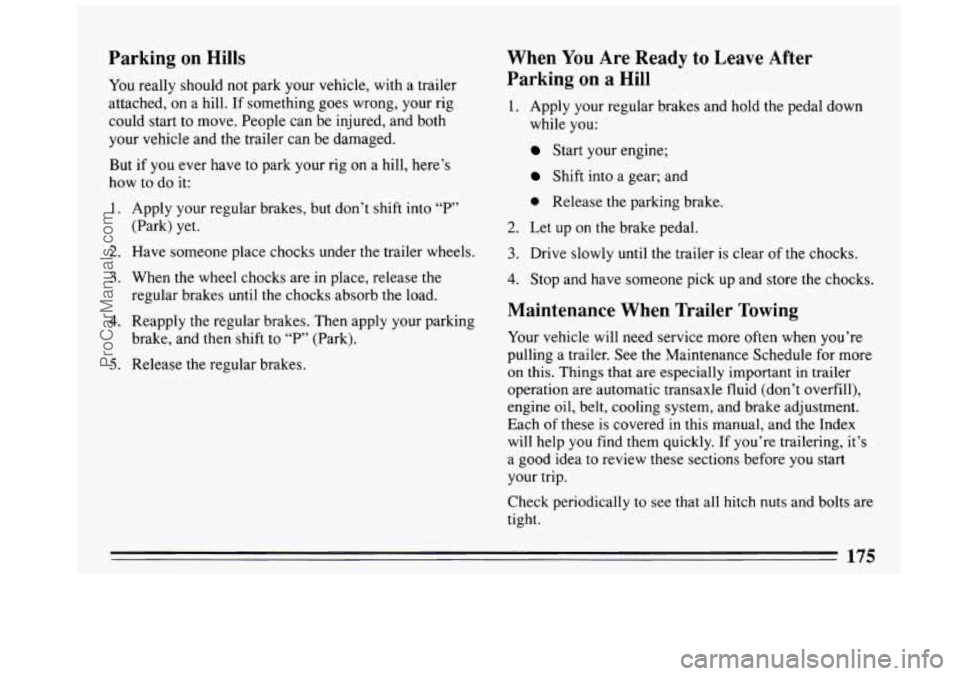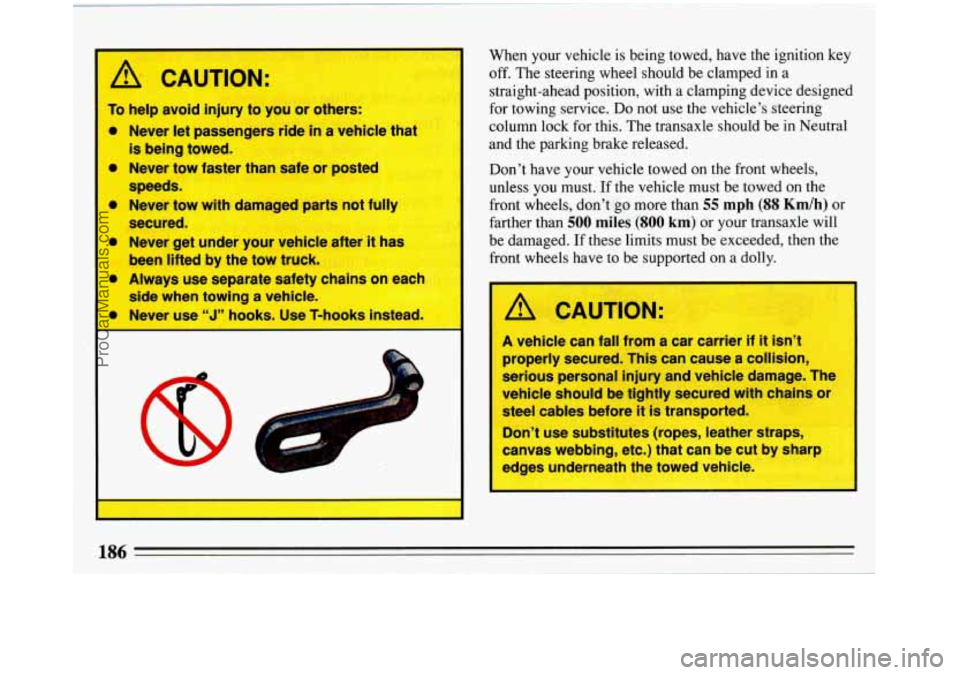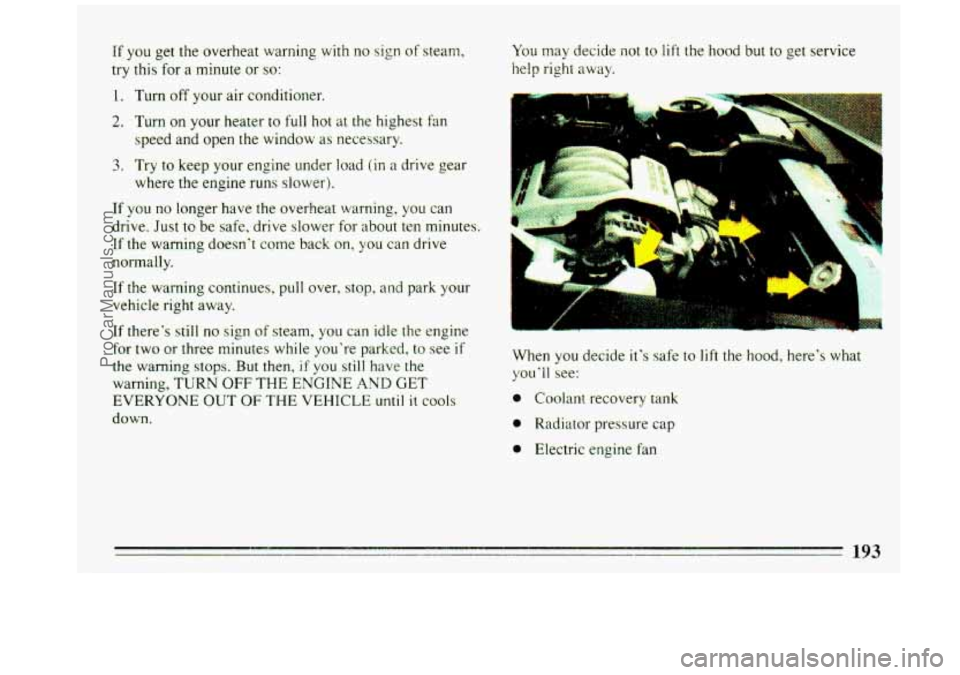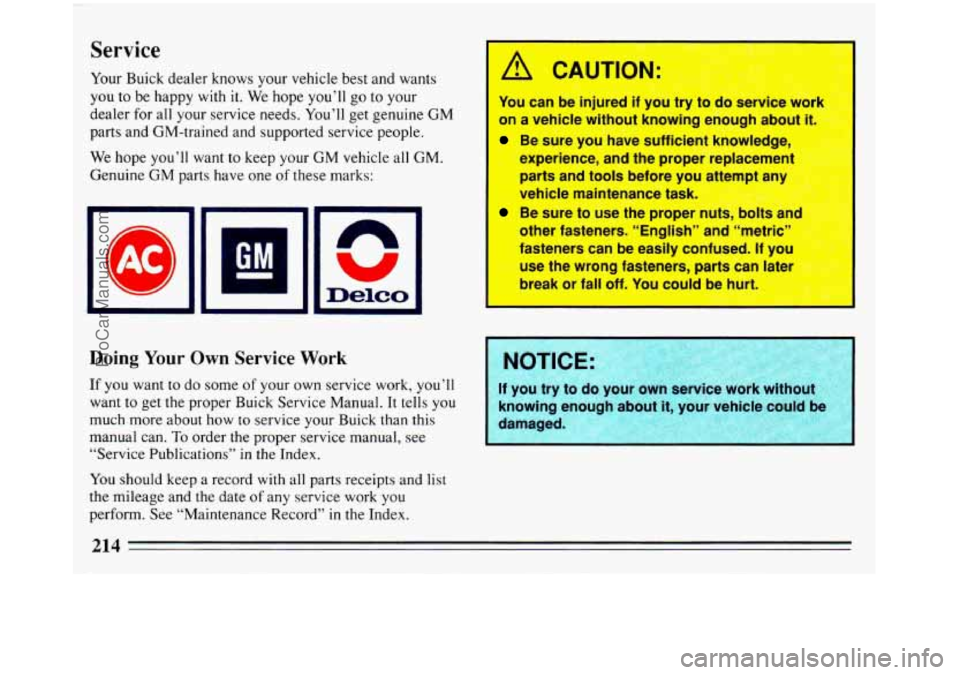Page 177 of 308

Parking on Hills
You really should not park your vehicle, with a trailer
attached, on a hill. If something goes wrong, your rig
could start to move. People can be injured, and both
your vehicle and the trailer can be damaged.
But if
you ever have to park your rig on a hill, here’s
how to do it:
1.
2.
3.
4.
5.
Apply your regular brakes, but don’t shift into “P’
(Park) yet.
Have someone place chocks under the trailer wheels.
When the wheel chocks are in place, release the
regular brakes until the chocks absorb the load.
Reapply the regular brakes. Then apply your parking
brake, and then shift to “P” (Park).
Release the regular brakes.
When You Are Ready to Leave After
Parking on
a Hill
1. Apply your regular brakes and hold the pedal down
while you:
Start your engine;
Shift into a gear; and
0 Release the parking brake.
2. Let up on the brake pedal.
3. Drive slowly until the trailer is clear of the chocks.
4. Stop and have someone pick up and store the chocks.
Maintenance When Trailer Towing
Your vehicle will need service more often when you’re
pulling a trailer. See the Maintenance Schedule for more
on this. Things that are especially important in trailer
operation are automatic transaxle fluid (don’t overfill),
engine oil, belt, cooling system, and brake adjustment.
Each
of these is covered in this manual, and the Index
will help you find them quickly. If you’re trailering, it’s
a good idea to review these sections before
you start
your trip.
Check periodically to see that all hitch nuts and bolts are
tight.
175
ProCarManuals.com
Page 186 of 308
Don’t let the other end touch anything until the next
step. The other end
of the negative cable doesn’t go
to the dead battery. It goes to a heavy unpainted
metal part
on the engine of the vehicle with the dead
battery.
9. Attach the cable at least 18 inches (45 cm) away
from the dead battery, but
not near engine parts that
move. The electrical connection is just
as good there,
but the chance of sparks getting back to the battery is
much less.
10. Now start the vehicle with the good battery and run
11. Try to start the vehicle with the dead battery.
the engine for a while.
If it won’t start after a few tries, it probably needs
service.
12. Remove the cables in reverse order to prevent
electrical shorting. Take care that they don’t touch
each other or any other metal.
184
-
ProCarManuals.com
Page 187 of 308
Towing Your Vehicle
Try to have a GM dealer or a professional towing
service tow your Ruick. The usual towing equipment
is
a sling-type (A) or a wheel-lift (B) or car carrier (C) tow
truck.
If your vehicle has been changed or modified since it
was factory-new by adding aftermarket items like fog
lamps, aero skirting, or special tires
and wheels, these
instructions and illustrations may not
be correct. Before
you do anything,
turn on the hazard warning
flashers.
When you call, tell the towing service:
That your vehicle has front-wheel drive.
0 The make, model, and year of your vehicle.
Whether you can still move the shift lever.
If there was an accident, what was damaged.
When
the towing service arrives, let the tow operator
know that this manual contains detailed towing
instructions and illustrations. The operator may want to
see them.
ProCarManuals.com
Page 188 of 308

0
0
0
0 0
0
'AA"TT
To help avoid injury to you or others:
Never let passengers ride
in a vehicle that
is being towed.
Never tow faster than safe or posted
speeds.
Never tow with damaged parts not fully
secured.
Never get under your vehicle after
it has
been lifted by the tow truck.
Always use separate safetv chains on each
side when towing
a vehic ~
Never use "J" hnnks- Use T-hanks i
When your vehicle is being towed, have the ignition key
off. The steering wheel should be clamped in a
straight-ahead position, with a clamping device designed
for towing service.
Do not use the vehicle's steering
column lock for this. The transaxle should be in Neutral
and the parking brake released.
Don't have your vehicle towed on the front wheels,
unless
you must. If the vehicle must be towed on the
front wheels, don't
go more than 55 mph (88 Km/h) or
farther than
500 miles (800 km) or your transaxle will
be damaged.
If these limits must be exceeded, then the
front wheels have to be supported
on a dolly.
/1 CAUTION:
A vehicle can fall from a car carrier if it isn't
properly secured. This can cause a collision,
serious personal injury and vehicle damage. The
vehicle should be tightly secured with chains or
steel cables before
it is transported.
Don't use substitutes (ropes, leather straps,
canvas webbing, etc.) that can be cut by sharp
edges underneath the towed vehicle.
186
ProCarManuals.com
Page 195 of 308

If you get the overheat warning with no sign of steam,
try this for
a minute or so:
1.
2.
3.
Turn off your air conditioner.
Turn on
your heater to full hot
speed and open the window as
Try to keep your engine under
where the engine runs slower). at
the highest fan
necessary.
load (in a drive gear
If you no longer have the overheat warning,
you can
drive. Just to be safe, drive slower
for about ten minutes.
If the warning doesn‘t corne back on, you can drive
normally.
If the warning continues, pull over, stop, and park
your
vehicle right away.
If there’s still
no sign of steam, you can idle the engine
for two
or three minutes while you’re parked, to see if
the warning stops. But then, if you still have the
warning,
TURN OFF THE ENGINE AND GET
EVERYONE
OUT OF THE VEHICLE until it cools
down.
You may decide not to lift the hood but to get service
help right
away.
m .... ... ..
h 1
When you decide it’s safe to lift the hood, here’s what
you’ll
see:
0 Coolant recovery tank
0 Radiator pressure cap
0 Electric engine fan
ProCarManuals.com
Page 196 of 308
tder the hood can =&drt up even
is not running and can injure
--, clothing and tools away frnm
I nlcwtric fan-
~ ~~~~ ---
If the coolant inside the coolant recovery tank is boiling,
don’t do anything else until it
cools down. The
coolant level should be at or above the
“COLD”. If
it isn’t, you may have a leak in the radiator hoses, heater
hoses, radiator, water pump or somewhere else
in the
cooling system.
9
Heater and radiator hoses, and other englne
parts, can be very hot.
do, you can be burned.
Don’t run the engine
if there is a leak. If you r,,,
the engine, it could lose all coolant. That could
cause an engine fire, and you could be burned
my leak fixed before you drive +he vehicl,.
I U
If there seems to be no leak, check to see if the electric
engine fan
is running. If the engine is overheating, the
fan should be running.
If it isn’t, your vehicle needs
service.
194
ProCarManuals.com
Page 215 of 308

Part 6 Service And Appearance Care
vehicle, and a section devoted to its appearance care.
Part
6 includes:
ServiceTips
...................................................................... 214
Fuel ........................................................................\
.....
HoodRelease ..................................................................... 218
EngineOil ....................................................................... \
AirCleane r.. ..................................................................... 225
Automatic Transaxle Fluid ...........................................................
Enginecoolant .................................................................... 228
Power Steering Fluid .......................... % ....................................
Windshield Washer Fluid ............................................................ 232
Brakes ........................................................................\
...
Battery ........................................................................\
.. 235
BulbReplacement ................................................................. 236
LoadingYourVehicle ...............................................................
Tires ........................................................................\
....
Appearancecare ..................................................................
Vehicle Identification Number (VIN) ..................................................
FusesandCircuitBreakers ........................................................... 257
Capacities and Specifications ......................................................... 263
ProCarManuals.com
Page 216 of 308

Service
Your Buick dealer knows your vehicle best and wants
you to be happy with
it. We hope you’ll go to your
dealer for all your service needs. You’ll get genuine
GM
parts and GM-trained and supported service people.
We hope you’ll want to keep your GM vehicle all
GM.
Genuine GM parts have one of these marks:
Doing Your Own Service Work
If you want to do some of your own service work, you’ll
want to get the proper Buick Service Manual. It tells you
much.more about how to service your Buick than this
manual can.
To order the proper service manual, see
“Service Publications” in the Index.
I A CAUTlvN:
You can be injured if you try to do service work
on a vehicle without knowing enough about it
Be sure you have sufficient knowledge,
experience, and the proper replacement
parts and tools before you attempt any
vehicle maintenance task.
Be sure to use the proper nuts, bolts ancI
other fasteners. “English” and “metric”
fasteners
can be easily confused. If you
use the wrong fasteners, parts can later
break or fall off. You could be hurt.
You should keep a record with all parts receipts and list
the mileage and
the date of any service work you
perform. See “Maintenance Record” in the Index.
214
ProCarManuals.com